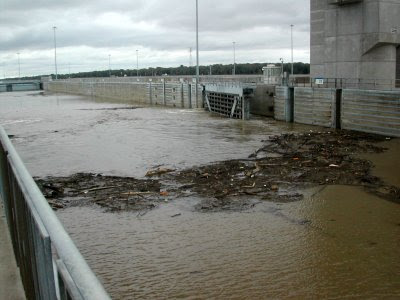Cruising on the rivers we encounter a lot of tows. When we were still sailing on the river we always referred to them as barges, as in "do you see that barge coming". But the truth is that the towboat pushes individual barges, usually more than one and generally as many as 15 lashed together 3 across and 5 deep; the entire assembly is referred to as a "tow". The 15 barge tow that I mentioned is the norm on the Upper Mississippi but on the lower Mississippi (below Cairo, IL) a towboat may push as many as 40 barges. On the rivers that we have traveled on there is no "towing" involved but in the Chesapeake and the Gulf of Mexico we have observed barges being towed.
Whatever you choose to call them I think they are one of the most majestic sights we encounter on the waterway. You may not call them beautiful but they are awesome in their quiet power. Plying the waterways 24/7 they operate in all extremes of weather.
A tow boat Captain has the tow strung out in front of him about 1/4 mile (on a standard 15 barge tow) and he has to maneuver it around corners and into locks and docks and loading facilities. All of the propulsion for forward movement and maneuvering is on the towboat, the barges themselves have no propulsion. Just imagine trying to maneuver into a lock that is only a few feet wider than your 3 lead barges. Now imagine doing it in the dark, in the rain (or snow or fog), yikes! These guys are very skilled and they are also generally helpful to pleasure boaters, or RVs (recreational vessels) as they sometimes refer to us.

Barge transportation is incredibly efficient. Each barge can carry 1,500 Tons, or 52,500 Bushels or 453,600 Gallons. The capacity of a single barge is 15 times greater than one rail car and 60 times greater than one semi trailer.

Generally speaking towboats are kept clean and freshly painted. When the crew does not have deck duties they utilize the time to see to scrubbing or painting the towboat, it is a huge floating billboard for the corporation that owns it.


We have had the opportunity to lock through with tows on several occasions. The first time we were apprehensive because we had heard stories but our experience was that the tow Captain was very courteous and also very conscious of our safety and comfort as well as the safety of our boat.


























